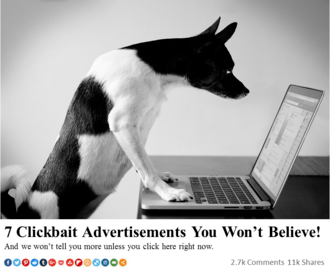Clickbait
Clickbait is a text or thumbnail link that is designed to entice users to follow that link and read, view, or listen to the linked piece of online content.[2][3]
Click-bait headlines typically aim to exploit the "curiosity gap", providing just enough information to make readers of news websites curious, but not enough to satisfy their curiosity without clicking through to the linked content.[4][5][6]
Clickbait journalism
From a historical perspective, the techniques employed by clickbait authors can be considered derivative of yellow journalism, which presented little or no legitimate well-researched news and instead used eye-catching headlines that included exaggerations of news events, scandal-mongering, or sensationalism.[7][8] For sites that thrive on thousands of click-throughs to content, many authors see the use of clickbait as a means to tap into human psyche by crafting these eye-catching headlines.[9]
Backlash
By 2014, the ubiquity of clickbait on the web had begun to lead to a backlash against its use.[6][10] Satirical newspaper The Onion launched a new website, ClickHole, that parodied clickbait websites such as Upworthy and BuzzFeed,[11] and in August 2014, Facebook announced that it was taking technical measures to reduce the impact of clickbait on its social network,[12][13][14] using, among other cues, the time spent by the user on visiting the linked page as a way of distinguishing clickbait from other types of content.[15] Ad blockers and a general fall in advertising clicks also affected the clickbait model, as websites moved towards sponsored advertising and native advertising where the content of the article was more important than the click-rate.[16]
Social media groups, such as Stop Clickbait,[17][18][19][20] combat clickbait by giving a short summary of the clickbait article, closing the "curiosity gap".
Clickbait has also been used to political ends, and in this respect has been blamed for the rise of post-truth politics. Katherine Viner, editor-in-chief at The Guardian wrote that "chasing down cheap clicks at the expense of accuracy and veracity" undermined the value of journalism and truth.[21] Emotional subjects with stark headlines are widely shared and clicked, which resulted in what Slate described as an "aggregation of outrage" and a proliferation of websites across the political spectrum – including Breitbart News, Huffington Post, Salon, Townhall and the Gawker Media blogs – which profited by producing shareable short-form pieces offering simple moral judgements on political and cultural issues.[16]
See also
| Look up clickbait in Wiktionary, the free dictionary. |
References
- ↑ Gardiner, Bryan (December 18, 2015). "You'll Be Outraged At How Easy It Was To Get You To Click On This Headline". Wired. Retrieved 2 August 2018.
- ↑ O'Donovan, Caroline. "What is clickbait?". www.niemanlab.org. Niewman labs. Retrieved 12 June 2018.
- ↑ Frampton, Ben (14 September 2015). "Clickbait - the changing face of online journalism". BBC. Retrieved 12 June 2018.
- ↑ Derek Thompson (November 14, 2013). "Upworthy: I Thought This Website Was Crazy, but What Happened Next Changed Everything". The Atlantic.
- ↑ Katy Waldman (May 23, 2014). "Mind the 'curiosity gap': How can Upworthy be 'noble' and right when its clickbait headlines feel so wrong?". National Post.
- 1 2 Emily Shire (14 July 2014). "Saving Us From Ourselves: The Anti-Clickbait Movement". The Daily Beast.
- ↑ Ingram, Mathew (1 April 2014). "The internet didn't invent viral content or clickbait journalism — there's just more of it now, and it happens faster". GigaOM. Retrieved 6 August 2016.
- ↑ Drell, Cady (29 July 2016). "How Son of Sam Changed America". Rolling Stone. Retrieved 6 August 2016.
- ↑ Zarrin Haque (October 1, 2017). "The Art of Clickbait". Somiibo.
- ↑ Christine Lagorio-Chafkin (Jan 27, 2014). "Clickbait Bites. Downworthy Is Actually Doing Something About It". Inc.
- ↑ Oremus, Will (2014-06-19). "Clickhole: The Onion's new site is more than a BuzzFeed parody". Slate.com. Retrieved 2017-02-24.
- ↑ Lisa Visentin (August 26, 2014). "Facebook wages war on click-bait". The Sydney Morning Herald.
- ↑ Andrew Leonard (Aug 25, 2014). "Why Mark Zuckerberg's war on click bait proves we are all pawns of social media". Salon.
- ↑ Khalid El-Arini and Joyce Tang (August 25, 2014). "News Feed FYI: Click-baiting". Facebook Inc.
- ↑ Ravi Somaiya (August 25, 2014). "Facebook Takes Steps Against 'Click Bait' Articles". The New York Times.
- 1 2 David Auerbach (10 March 2015). "The Death of Outrage". Slate. Retrieved 6 August 2016.
- ↑ Greta J. "10+ Times 'Stop Clickbait' Hilariously Summarized Crappy Articles And Saved You A Click".
- ↑ "Stop Clickbait". Know Your Meme.
- ↑ KUSA Staff (2017-05-19). "What this CU student is doing about clickbait will surprise you!".
- ↑ "This Article About Stopping Clickbait Isn't Clickbait. We Promise".
- ↑ Katherine Viner (12 July 2016). "How technology disrupted the truth". The Guardian. Retrieved 12 July 2016.
